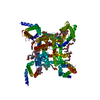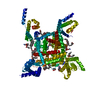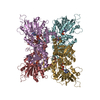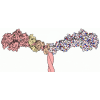[English] 日本語
 Yorodumi
Yorodumi- EMDB-9780: Molecular basis for pore blockade of human Sodium channel Nav1.2 ... -
+ Open data
Open data
- Basic information
Basic information
| Entry | Database: EMDB / ID: EMD-9780 | |||||||||
|---|---|---|---|---|---|---|---|---|---|---|
| Title | Molecular basis for pore blockade of human Sodium channel Nav1.2 by mu-conotoxin KIIIA | |||||||||
 Map data Map data | The map after postprocessing in RELION2.1. | |||||||||
 Sample Sample |
| |||||||||
| Function / homology |  Function and homology information Function and homology informationresponse to pyrethroid / voltage-gated sodium channel activity involved in cardiac muscle cell action potential / regulation of atrial cardiac muscle cell membrane depolarization / voltage-gated potassium channel activity involved in ventricular cardiac muscle cell action potential repolarization / intrinsic apoptotic signaling pathway in response to osmotic stress / cardiac conduction / membrane depolarization during cardiac muscle cell action potential / membrane depolarization during action potential / positive regulation of sodium ion transport / axon initial segment ...response to pyrethroid / voltage-gated sodium channel activity involved in cardiac muscle cell action potential / regulation of atrial cardiac muscle cell membrane depolarization / voltage-gated potassium channel activity involved in ventricular cardiac muscle cell action potential repolarization / intrinsic apoptotic signaling pathway in response to osmotic stress / cardiac conduction / membrane depolarization during cardiac muscle cell action potential / membrane depolarization during action potential / positive regulation of sodium ion transport / axon initial segment / cardiac muscle cell action potential involved in contraction / node of Ranvier / voltage-gated sodium channel complex / Interaction between L1 and Ankyrins / voltage-gated sodium channel activity / sodium ion transport / Phase 0 - rapid depolarisation / regulation of heart rate by cardiac conduction / sodium channel regulator activity / neuronal action potential / cardiac muscle contraction / myelination / T-tubule / sodium ion transmembrane transport / memory / Sensory perception of sweet, bitter, and umami (glutamate) taste / nervous system development / toxin activity / response to heat / neuron apoptotic process / cellular response to hypoxia / gene expression / chemical synaptic transmission / calmodulin binding / axon / synapse / extracellular region / membrane / plasma membrane Similarity search - Function | |||||||||
| Biological species |  Homo sapiens (human) / Homo sapiens (human) /  Conus kinoshitai (invertebrata) Conus kinoshitai (invertebrata) | |||||||||
| Method | single particle reconstruction / cryo EM / Resolution: 3.0 Å | |||||||||
 Authors Authors | Pan X / Li Z / Huang X / Huang G / Shen H / Lei J / Yan N | |||||||||
 Citation Citation |  Journal: Science / Year: 2019 Journal: Science / Year: 2019Title: Molecular basis for pore blockade of human Na channel Na1.2 by the μ-conotoxin KIIIA. Authors: Xiaojing Pan / Zhangqiang Li / Xiaoshuang Huang / Gaoxingyu Huang / Shuai Gao / Huaizong Shen / Lei Liu / Jianlin Lei / Nieng Yan /  Abstract: The voltage-gated sodium channel Na1.2 is responsible for the initiation and propagation of action potentials in the central nervous system. We report the cryo-electron microscopy structure of human ...The voltage-gated sodium channel Na1.2 is responsible for the initiation and propagation of action potentials in the central nervous system. We report the cryo-electron microscopy structure of human Na1.2 bound to a peptidic pore blocker, the μ-conotoxin KIIIA, in the presence of an auxiliary subunit, β2, to an overall resolution of 3.0 angstroms. The immunoglobulin domain of β2 interacts with the shoulder of the pore domain through a disulfide bond. The 16-residue KIIIA interacts with the extracellular segments in repeats I to III, placing Lys at the entrance to the selectivity filter. Many interacting residues are specific to Na1.2, revealing a molecular basis for KIIIA specificity. The structure establishes a framework for the rational design of subtype-specific blockers for Na channels. | |||||||||
| History |
|
- Structure visualization
Structure visualization
| Movie |
 Movie viewer Movie viewer |
|---|---|
| Structure viewer | EM map:  SurfView SurfView Molmil Molmil Jmol/JSmol Jmol/JSmol |
| Supplemental images |
- Downloads & links
Downloads & links
-EMDB archive
| Map data |  emd_9780.map.gz emd_9780.map.gz | 49 MB |  EMDB map data format EMDB map data format | |
|---|---|---|---|---|
| Header (meta data) |  emd-9780-v30.xml emd-9780-v30.xml emd-9780.xml emd-9780.xml | 13.1 KB 13.1 KB | Display Display |  EMDB header EMDB header |
| Images |  emd_9780.png emd_9780.png | 17.9 KB | ||
| Archive directory |  http://ftp.pdbj.org/pub/emdb/structures/EMD-9780 http://ftp.pdbj.org/pub/emdb/structures/EMD-9780 ftp://ftp.pdbj.org/pub/emdb/structures/EMD-9780 ftp://ftp.pdbj.org/pub/emdb/structures/EMD-9780 | HTTPS FTP |
-Validation report
| Summary document |  emd_9780_validation.pdf.gz emd_9780_validation.pdf.gz | 361.4 KB | Display |  EMDB validaton report EMDB validaton report |
|---|---|---|---|---|
| Full document |  emd_9780_full_validation.pdf.gz emd_9780_full_validation.pdf.gz | 360.9 KB | Display | |
| Data in XML |  emd_9780_validation.xml.gz emd_9780_validation.xml.gz | 6 KB | Display | |
| Arichive directory |  https://ftp.pdbj.org/pub/emdb/validation_reports/EMD-9780 https://ftp.pdbj.org/pub/emdb/validation_reports/EMD-9780 ftp://ftp.pdbj.org/pub/emdb/validation_reports/EMD-9780 ftp://ftp.pdbj.org/pub/emdb/validation_reports/EMD-9780 | HTTPS FTP |
-Related structure data
| Related structure data |  6j8eMC M: atomic model generated by this map C: citing same article ( |
|---|---|
| Similar structure data |
- Links
Links
| EMDB pages |  EMDB (EBI/PDBe) / EMDB (EBI/PDBe) /  EMDataResource EMDataResource |
|---|---|
| Related items in Molecule of the Month |
- Map
Map
| File |  Download / File: emd_9780.map.gz / Format: CCP4 / Size: 52.7 MB / Type: IMAGE STORED AS FLOATING POINT NUMBER (4 BYTES) Download / File: emd_9780.map.gz / Format: CCP4 / Size: 52.7 MB / Type: IMAGE STORED AS FLOATING POINT NUMBER (4 BYTES) | ||||||||||||||||||||||||||||||||||||||||||||||||||||||||||||
|---|---|---|---|---|---|---|---|---|---|---|---|---|---|---|---|---|---|---|---|---|---|---|---|---|---|---|---|---|---|---|---|---|---|---|---|---|---|---|---|---|---|---|---|---|---|---|---|---|---|---|---|---|---|---|---|---|---|---|---|---|---|
| Annotation | The map after postprocessing in RELION2.1. | ||||||||||||||||||||||||||||||||||||||||||||||||||||||||||||
| Projections & slices | Image control
Images are generated by Spider. | ||||||||||||||||||||||||||||||||||||||||||||||||||||||||||||
| Voxel size | X=Y=Z: 1.091 Å | ||||||||||||||||||||||||||||||||||||||||||||||||||||||||||||
| Density |
| ||||||||||||||||||||||||||||||||||||||||||||||||||||||||||||
| Symmetry | Space group: 1 | ||||||||||||||||||||||||||||||||||||||||||||||||||||||||||||
| Details | EMDB XML:
CCP4 map header:
| ||||||||||||||||||||||||||||||||||||||||||||||||||||||||||||
-Supplemental data
- Sample components
Sample components
-Entire : Nav1.2-beta2-KIIIA
| Entire | Name: Nav1.2-beta2-KIIIA |
|---|---|
| Components |
|
-Supramolecule #1: Nav1.2-beta2-KIIIA
| Supramolecule | Name: Nav1.2-beta2-KIIIA / type: complex / ID: 1 / Parent: 0 / Macromolecule list: #1 Details: Ternary complex of Human Nav1.2 with Human Voltage-gated sodium channel auxilliary subunit beta2 and mu-conotoxin KIIIA |
|---|---|
| Molecular weight | Experimental: 252 kDa/nm |
-Supramolecule #2: Nav1.2-beta2
| Supramolecule | Name: Nav1.2-beta2 / type: complex / ID: 2 / Parent: 1 Details: Human Nav1.2 with Human Voltage-gated sodium channel auxilliary subunit beta2 |
|---|---|
| Source (natural) | Organism:  Homo sapiens (human) Homo sapiens (human) |
| Recombinant expression | Organism:  Homo sapiens (human) Homo sapiens (human) |
-Supramolecule #3: KIIIA
| Supramolecule | Name: KIIIA / type: complex / ID: 3 / Parent: 1 / Details: mu-conotoxin KIIIA |
|---|---|
| Source (natural) | Organism:  Conus kinoshitai (invertebrata) Conus kinoshitai (invertebrata) |
-Macromolecule #1: Human Voltage gated sodium channel sub-type 1.2
| Macromolecule | Name: Human Voltage gated sodium channel sub-type 1.2 / type: protein_or_peptide / ID: 1 / Enantiomer: LEVO |
|---|---|
| Source (natural) | Organism:  Homo sapiens (human) Homo sapiens (human) |
| Recombinant expression | Organism:  Homo sapiens (human) Homo sapiens (human) |
| Sequence | String: MASWSHPQFE KGGGARGGSG GGSWSHPQFE KGFDYKDDDD KGT MAQSVL VPPGPDSFRF FTRESLAAIE QRIAEEKAKR PKQERKDEDD ENGPKPNSDL EAGK SLPFI YGDIPPEMVS VPLEDLDPYY INKKTFIVLN KGKAISRFSA TPALYILTPF NPIRK LAIK ...String: MASWSHPQFE KGGGARGGSG GGSWSHPQFE KGFDYKDDDD KGT MAQSVL VPPGPDSFRF FTRESLAAIE QRIAEEKAKR PKQERKDEDD ENGPKPNSDL EAGK SLPFI YGDIPPEMVS VPLEDLDPYY INKKTFIVLN KGKAISRFSA TPALYILTPF NPIRK LAIK ILVHSLFNML IMCTILTNCV FMTMSNPPDW TKNVEYTFTG IYTFESLIKI LARGFC LED FTFLRDPWNW LDFTVITFAY VTEFVDLGNV SALRTFRVLR ALKTISVIPG LKTIVGA LI QSVKKLSDVM ILTVFCLSVF ALIGLQLFMG NLRNKCLQWP PDNSSFEINI TSFFNNSL D GNGTTFNRTV SIFNWDEYIE DKSHFYFLEG QNDALLCGNS SDAGQCPEGY ICVKAGRNP NYGYTSFDTF SWAFLSLFRL MTQDFWENLY QLTLRAAGKT YMIFFVLVIF LGSFYLINLI LAVVAMAYE EQNQATLEEA EQKEAEFQQM LEQLKKQQEE AQAAAAAASA ESRDFSGAGG I GVFSESSS VASKLSSKSE KELKNRRKKK KQKEQSGEEE KNDRVRKSES EDSIRRKGFR FS LEGSRLT YEKRFSSPHQ SLLSIRGSLF SPRRNSRASL FSFRGRAKDI GSENDFADDE HST FEDNDS RRDSLFVPHR HGERRHSNVS QASRASRVLP ILPMNGKMHS AVDCNGVVSL VGGP STLTS AGQLLPEGTT TETEIRKRRS SSYHVSMDLL EDPTSRQRAM SIASILTNTM EELEE SRQK CPPCWYKFAN MCLIWDCCKP WLKVKHLVNL VVMDPFVDLA ITICIVLNTL FMAMEH YPM TEQFSSVLSV GNLVFTGIFT AEMFLKIIAM DPYYYFQEGW NIFDGFIVSL SLMELGL AN VEGLSVLRSF RLLRVFKLAK SWPTLNMLIK IIGNSVGALG NLTLVLAIIV FIFAVVGM Q LFGKSYKECV CKISNDCELP RWHMHDFFHS FLIVFRVLCG EWIETMWDCM EVAGQTMCL TVFMMVMVIG NLVVLNLFLA LLLSSFSSDN LAATDDDNEM NNLQIAVGRM QKGIDFVKRK IREFIQKAF VRKQKALDEI KPLEDLNNKK DSCISNHTTI EIGKDLNYLK DGNGTTSGIG S SVEKYVVD ESDYMSFINN PSLTVTVPIA VGESDFENLN TEEFSSESDM EESKEKLNAT SS SEGSTVD IGAPAEGEQP EVEPEESLEP EACFTEDCVR KFKCCQISIE EGKGKLWWNL RKT CYKIVE HNWFETFIVF MILLSSGALA FEDIYIEQRK TIKTMLEYAD KVFTYIFILE MLLK WVAYG FQVYFTNAWC WLDFLIVDVS LVSLTANALG YSELGAIKSL RTLRALRPLR ALSRF EGMR VVVNALLGAI PSIMNVLLVC LIFWLIFSIM GVNLFAGKFY HCINYTTGEM FDVSVV NNY SECKALIESN QTARWKNVKV NFDNVGLGYL SLLQVATFKG WMDIMYAAVD SRNVELQ PK YEDNLYMYLY FVIFIIFGSF FTLNLFIGVI IDNFNQQKKK FGGQDIFMTE EQKKYYNA M KKLGSKKPQK PIPRPANKFQ GMVFDFVTKQ VFDISIMILI CLNMVTMMVE TDDQSQEMT NILYWINLVF IVLFTGECVL KLISLRYYYF TIGWNIFDFV VVILSIVGMF LAELIEKYFV SPTLFRVIR LARIGRILRL IKGAKGIRTL LFALMMSLPA LFNIGLLLFL VMFIYAIFGM S NFAYVKRE VGIDDMFNFE TFGNSMICLF QITTSAGWDG LLAPILNSGP PDCDPDKDHP GS SVKGDCG NPSVGIFFFV SYIIISFLVV VNMYIAVILE NFSVATEESA EPLSEDDFEM FYE VWEKFD PDATQFIEFA KLSDFADALD PPLLIAKPNK VQLIAMDLPM VSGDRIHCLD ILFA FTKRV LGESGEMDAL RIQMEERFMA SNPSKVSYEP ITTTLKRKQE EVSAIIIQRA YRRYL LKQK VKKVSSIYKK DKGKECDGTP IKEDTLIDKL NENSTPEKTD MTPSTTSPPS YDSVTK PEK EKFEKDKSEK EDKGKDIRES KK |
-Macromolecule #2: Sodium channel protein type 2 subunit alpha
| Macromolecule | Name: Sodium channel protein type 2 subunit alpha / type: protein_or_peptide / ID: 2 / Enantiomer: LEVO |
|---|---|
| Source (natural) | Organism:  Homo sapiens (human) Homo sapiens (human) |
| Sequence | String: GRSMEVTVPA TLNVLNGSDA RLPCTFNSCY TVNHKQFSLN WTYQECNNCS EEMFLQFRMK IINLKLERFQ DRVEFSGNPS KYDVSVMLR NVQPEDEGIY NCYIMNPPDR HRGHGKIHLQ VLM |
-Macromolecule #3: Mu-conotoxin KIIIA
| Macromolecule | Name: Mu-conotoxin KIIIA / type: protein_or_peptide / ID: 3 / Enantiomer: LEVO |
|---|---|
| Source (natural) | Organism:  Conus kinoshitai (invertebrata) Conus kinoshitai (invertebrata) |
| Sequence | String: CCNCSSKWCR DHSRCC |
-Experimental details
-Structure determination
| Method | cryo EM |
|---|---|
 Processing Processing | single particle reconstruction |
| Aggregation state | particle |
- Sample preparation
Sample preparation
| Concentration | 1 mg/mL |
|---|---|
| Buffer | pH: 5.9 |
| Vitrification | Cryogen name: ETHANE |
- Electron microscopy
Electron microscopy
| Microscope | FEI TITAN KRIOS |
|---|---|
| Image recording | Film or detector model: GATAN K2 QUANTUM (4k x 4k) / Detector mode: SUPER-RESOLUTION / Average electron dose: 48.0 e/Å2 |
| Electron beam | Acceleration voltage: 300 kV / Electron source:  FIELD EMISSION GUN FIELD EMISSION GUN |
| Electron optics | Illumination mode: FLOOD BEAM / Imaging mode: BRIGHT FIELD |
| Experimental equipment |  Model: Titan Krios / Image courtesy: FEI Company |
- Image processing
Image processing
| Final reconstruction | Number classes used: 1 / Resolution.type: BY AUTHOR / Resolution: 3.0 Å / Resolution method: FSC 0.143 CUT-OFF / Number images used: 200275 |
|---|---|
| Initial angle assignment | Type: MAXIMUM LIKELIHOOD |
| Final angle assignment | Type: MAXIMUM LIKELIHOOD |
-Atomic model buiding 1
| Refinement | Protocol: RIGID BODY FIT |
|---|---|
| Output model |  PDB-6j8e: |
 Movie
Movie Controller
Controller
















 Z (Sec.)
Z (Sec.) Y (Row.)
Y (Row.) X (Col.)
X (Col.)





















